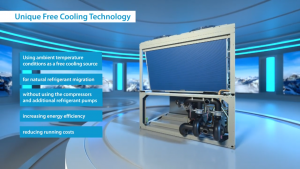R-32 Free Cooling is a very interesting technology, especially when it comes to bringing down operating costs and increase the efficiency of a hydronic system.

HVAC systems account for about 50% of the energy consumption in buildings in the European Union’s annual energy consumption. And that clearly explains how HVAC systems can determine the overall efficiency of a building and the impact it can have on the environment.
So, as regulations require building to be more and more efficient in the way they use energy, this also explains how important is for the building sector to find ways to minimize the impact of HVAC systems on the overall performance of a building.
Free cooling is certainly a very valuable technology for buildings that can benefit from certain climatic conditions, and for this reason it is a solution that consultants can count on when working at certain projects.
What is Free Cooling
When we talk about Free Cooling we usually talk about the ability if a chiller to use low external air temperatures to assist in chilling water, which then ca be used for industrial processes or air conditioning systems. So how that happen? Essentially, when outdoor temperatures are favourable, chillers turn off compressors and take advantage of the low outdoor temperature to chill water.
R-32-based Free Cooling
Other than introducing ground-breaking products benefitting from the use of R-32 refrigerant, like the R-32 chiller EWAT-B- and the R-32 heat pump EWYT-B-, Daikin has also introduced in 2018 the R-32 based Free Cooling option for the EWAT-B- chiller.
So, what differentiated this Free Cooling technology from all other Free Cooling types? The answer is natural migration.
This Free Cooling is designed to take advantage of the specific characteristics of the R-32 refrigerant. R-32 is an ideal refrigerant for natural migration, namely the free circulation of refrigerant within the unit’s circuit, with no need for additional pumps.
Some background about R-32 Free Cooling development
But let’s get some more information on how Daikin was able to come up with this solution with Luca Del Ferraro, Engineering Director at Daikin Applied Europe:
“The Free-Cooling option came as a result of brainstorming within the R&D team after a series of tests we had done on the refrigerant migration with other gases. When R-32 came into the picture, we understood we had a potential we had to take advantage of. However, our tests indicated clearly which were the factors limiting the refrigerant flow during the migration process. Here we developed the patented idea of “full free-cooling” with a dedicated heat exchanger, able to triple the capacity versus a similar chiller equipped with a standard evaporator.
Today our product portfolio includes both the “light” and the “full” free-cooling options, thus covering different needs, from the data center or process cooling to small comfort applications in northern climates, where part load cooling is required and outdoor conditions allow for the free cooling to operate. One of the biggest advantages of both solutions is being “plug and play”: everything is in the package, and the client does not have to concern about the use of glycol, as free-cooling is done with the refrigerant, evaporators are properly isolated and the control logic avoids freezing. With the optional pump kit, everything is included and contained in the same footprint as the standard chiller. No special transport and no special arrangement for installation and maintenance is required.”
The benefit of using R-32 natural migration based Free Cooling

The R-32 based Free Cooling stands out for being not only a great solution to improve the overall efficiency of a building when outdoor conditions are favorable. It is also a great solution because natural migration allows to cut out components like additional refrigerant pumps, and that results not only in easier installation, but also in a more compact unit footprint. And most importantly, that results in having less parts subject to maintenance, which of course implies lower operative costs.
And last but not least, the R-32 based Free Cooling is more efficient compared to standard free cooling systems, which typically require glycol water content of 30% or a free cooling separation plate heat exchanger, that reduce the overall system efficiency.
Do you want to know more about Daikin R-32 based Free Cooling? Then, get in touch with the form below.
